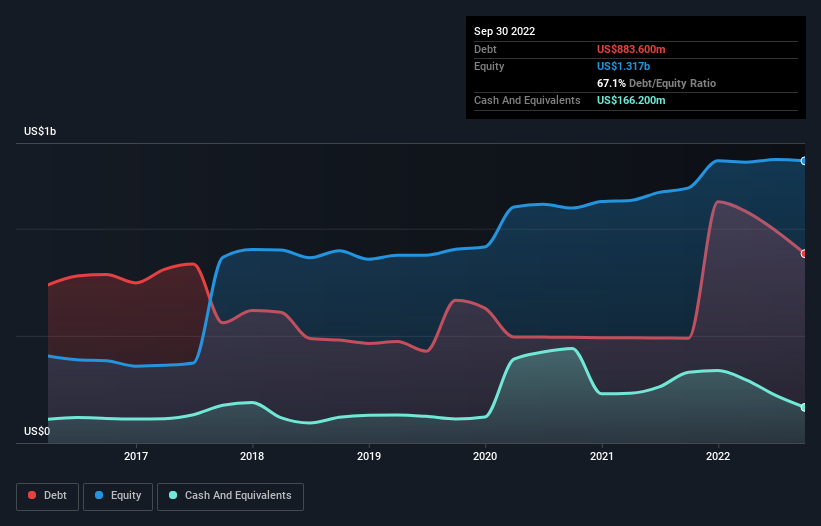
Some say volatility, rather than debt, is the best way to think about risk as an investor, but Warren Buffett famously said that ‘Volatility is far from synonymous with risk.’ So it might be obvious that you need to consider debt, when you think about how risky any given stock is, because too much debt can sink a company. We can see that EnPro Industries, Inc. (NYSE:NPO) does use debt in its business. But is this debt a concern to shareholders?
Why Does Debt Bring Risk?
Generally speaking, debt only becomes a real problem when a company can’t easily pay it off, either by raising capital or with its own cash flow. Ultimately, if the company can’t fulfill its legal obligations to repay debt, shareholders could walk away with nothing. However, a more frequent (but still costly) occurrence is where a company must issue shares at bargain-basement prices, permanently diluting shareholders, just to shore up its balance sheet. Of course, the upside of debt is that it often represents cheap capital, especially when it replaces dilution in a company with the ability to reinvest at high rates of return. When we examine debt levels, we first consider both cash and debt levels, together.
See our latest analysis for EnPro Industries
What Is EnPro Industries’s Net Debt?
The image below, which you can click on for greater detail, shows that at September 2022 EnPro Industries had debt of US$883.6m, up from US$489.4m in one year. However, because it has a cash reserve of US$166.2m, its net debt is less, at about US$717.4m.

A Look At EnPro Industries’ Liabilities
The latest balance sheet data shows that EnPro Industries had liabilities of US$253.3m due within a year, and liabilities of US$1.12b falling due after that. Offsetting this, it had US$166.2m in cash and US$151.4m in receivables that were due within 12 months. So its liabilities total US$1.06b more than the combination of its cash and short-term receivables.
While this might seem like a lot, it is not so bad since EnPro Industries has a market capitalization of US$2.45b, and so it could probably strengthen its balance sheet by raising capital if it needed to. But we definitely want to keep our eyes open to indications that its debt is bringing too much risk.
We measure a company’s debt load relative to its earnings power by looking at its net debt divided by its earnings before interest, tax, depreciation, and amortization (EBITDA) and by calculating how easily its earnings before interest and tax (EBIT) cover its interest expense (interest cover). Thus we consider debt relative to earnings both with and without depreciation and amortization expenses.
EnPro Industries’s debt is 2.8 times its EBITDA, and its EBIT cover its interest expense 5.5 times over. Taken together this implies that, while we wouldn’t want to see debt levels rise, we think it can handle its current leverage. It is well worth noting that EnPro Industries’s EBIT shot up like bamboo after rain, gaining 58% in the last twelve months. That’ll make it easier to manage its debt. There’s no doubt that we learn most about debt from the balance sheet. But it is future earnings, more than anything, that will determine EnPro Industries’s ability to maintain a healthy balance sheet going forward. So if you want to see what the professionals think, you might find this free report on analyst profit forecasts to be interesting.
Finally, while the tax-man may adore accounting profits, lenders only accept cold hard cash. So we always check how much of that EBIT is translated into free cash flow. During the last three years, EnPro Industries generated free cash flow amounting to a very robust 99% of its EBIT, more than we’d expect. That puts it in a very strong position to pay down debt.
Our View
Happily, EnPro Industries’s impressive conversion of EBIT to free cash flow implies it has the upper hand on its debt. But, on a more sombre note, we are a little concerned by its net debt to EBITDA. When we consider the range of factors above, it looks like EnPro Industries is pretty sensible with its use of debt. While that brings some risk, it can also enhance returns for shareholders. The balance sheet is clearly the area to focus on when you are analysing debt. But ultimately, every company can contain risks that exist outside of the balance sheet. Case in point: We’ve spotted 4 warning signs for EnPro Industries you should be aware of, and 2 of them don’t sit too well with us.
At the end of the day, it’s often better to focus on companies that are free from net debt. You can access our special list of such companies (all with a track record of profit growth). It’s free.
Valuation is complex, but we’re helping make it simple.
Find out whether EnPro Industries is potentially over or undervalued by checking out our comprehensive analysis, which includes fair value estimates, risks and warnings, dividends, insider transactions and financial health.
Have feedback on this article? Concerned about the content? Get in touch with us directly. Alternatively, email editorial-team (at) simplywallst.com.
This article by Simply Wall St is general in nature. We provide commentary based on historical data and analyst forecasts only using an unbiased methodology and our articles are not intended to be financial advice. It does not constitute a recommendation to buy or sell any stock, and does not take account of your objectives, or your financial situation. We aim to bring you long-term focused analysis driven by fundamental data. Note that our analysis may not factor in the latest price-sensitive company announcements or qualitative material. Simply Wall St has no position in any stocks mentioned.
Source link
